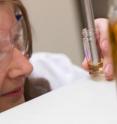How to tell real whiskey from fake -- faster
Methods for distinguishing between authentic and counterfeit Scotch whisky brands have been devised by scientists at the University of Strathclyde in Glasgow. Researchers from the Department of Pure and Applied Chemistry have found new ways to compare the content of whisky samples to determine if they are the whisky on the label or an imitation brand.
A series of blind tests successfully put the real whisky brand and the fakes in the right categories. The system could enhance the technology industry uses to tackle the trade in illicit whisky, which costs huge sums in lost revenue and threatens brand reputation.
Professor David Littlejohn, who led the research, said: "The whisky industry has tools at its disposal for telling authentic and counterfeit whisky brands apart but many of them involve lab-based analysis, which isn't always the most convenient system if a sample needs to be identified quickly.
"There's a growing need for methods that can provide simpler and faster identification and we have developed a system which could be adapted for devices to use on site, without the need to return samples to a lab. It could be of great benefit to an industry which is hugely important to the economy."
The researchers analysed 17 samples of blended whisky, looking at the concentration of ethanol in the samples without diluting them and the residue of dried whisky. They did so with mid-infrared spectrometry, used with immersion probes that incorporate novel optical fibres developed by Scottish based company Fibre Photonics Ltd, who co-sponsored the research. The procedures developed can provide prompt, accurate analysis without the complexity and cost of some other systems.
The levels of ethanol and colourant led them to identify correctly the eight authentic and nine counterfeit samples.
Financial support for the project was provided by the Scottish Funding Council (SFC), Fibre Photonics Ltd and WestCHEM, a joint research school formed by the Universities of Strathclyde and Glasgow. The SFC funding was for a studentship through its SPIRIT (Strategic Priority Investments in Research and Innovation Translation) programme.
The project research paper has been published in Analytica Chimica Acta.
Source: University of Strathclyde
Other sources
- New test tells real whiskey from fakefrom UPITue, 26 Jul 2011, 8:01:28 UTC
- New test tells real whiskey from fakefrom UPITue, 26 Jul 2011, 0:30:37 UTC
- How to tell real whiskey from fake -- fasterfrom PhysorgMon, 25 Jul 2011, 17:30:46 UTC
- How to tell real whiskey from fake, fasterfrom Science DailyMon, 25 Jul 2011, 17:30:12 UTC

